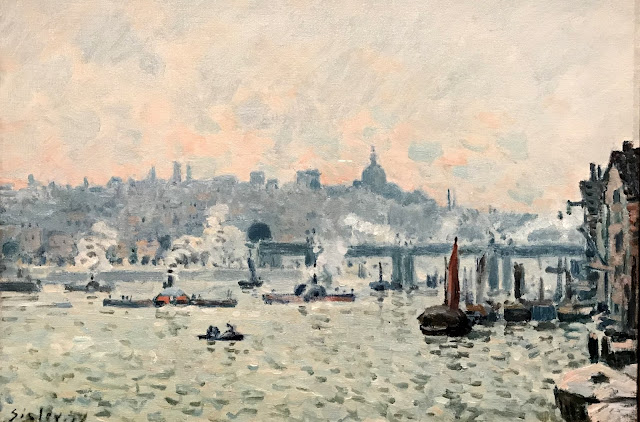The Impressionists in London, at Tate Britain.
Thousands of French nationals sought refuge in Britain around 1871, the 'Terrible Year' which left France drained and scarred after the defeat of the Franco-Prussian War and the Commune, the ensuing civil war in Paris. 'The horror and terror are still everywhere ... Paris is empty and will become even emptier ... Anyone would think there never were any painters and artists in Paris', wrote the critic Theodor Duret to Camille Pissarro.
The painters included in this exhibition came to London during or in the wake of these traumatic events to avoid conscription, to escape the Prussian invasion as political exiles or as economic migrants, almost invariably referring to their stay as 'exile'. They transformed representations of London.

Gustave Dore, Sister of Charity Saving a Child, Episode in the Siege of Paris, 1870-01, (oil paint on canvas)
Dore enlisted in the National Guard during the Franco-Prussian war. He witnessed this scene, which took place on the Left Bank, rue Gay-Lussac, by the convent of Sisters of the Adoration, in an area that was heavily pounded by the Germans. A frail nun carries a vulnerable child to safety in the night, casting a dramatic shadow on the blood-spattered and shrapnel-dotted snow.
Camille Pissarro, Crystal Palace, Upper Norwood, 1871, (oil paint on canvas)
Claude Monet, The Thames below Westminster, 1871 (oil on canvas)
Monet's subject here was resolutely modern: Westminster Bridge had been inaugurated in 1862, and the new Palace of Westminster was not fully completed until 1870, the same year as the Victoria Embankment. Workers can be seen dismantling the scaffolding that was assembled for its construction. For this open-air painting, Monet used a scumbling technique of soft colours to convey the depth and luminosity of the foggy sky with its pastel undertones, reserving contrasting broken brushstrokes for the treatment of reflections in the water.
Alfred Sisley, View of the Thames: Charing Cross Bridge, 1874, (oil on canvas)
Alfred Sisley, Molesey Weir, Hampton Court, Morning, 1874, (oil on canvas)
Modern life most attracted Sisley and he represented two bathers to the left, and a third man removing his socks to dabble in the river.
Claude Monet, Meditation (Madame Monet on the Sofa), 1871, (oil on canvas)
During his 7 to 8-month stay in London, Monet only painted 5 landscapes and this portrait of his wife Camille, who followed him there with their 3-year-old son. She is represented in their High Street Kensington flat, looking melancholy. The interior is sparse, but includes elements of early aesthetic decoration, such as the Japanese fan and blue china on the mantelpiece. These and the distinctly British floral chintz-upholstered chaise longue suggest Monet's attempt to suit English taste. The painting was exhibited in the French section of the 1871 International exhibition, but failed to find a buyer.
James Tissot, Portsmouth Dockyard, 1877, (oil on canvas)
James Tissot, The Ball on Shipboard, 1874, (oil on canvas)
The ship, with all its flags, is decorated in full dress, adding to the many colours of the elaborate dresses and uniforms. In the background, the sailors have become spectators, lined up to observe the performance of high society and royalty.
Alfred Sisley, The Bridge at Hampton Court, Mitre Inn, 1874, (oil on canvas)
Claude Monet, Houses of Parliament, Sunset, 1904, (oil on canvas)
Claude Monet, Houses of Parliament, Fog Effect, 1903, (oil on canvas)
Claude Monet, Charing Cross Bridge, 1899-1902, (oil on canvas)
In this composition the fog is too thick for the Palace of Westminster to be visible. A steam train in the centre of the composition is made more eye-catching than the familiar gothic architecture of the Houses of Parliament.
Claude Monet, Charing Cross Bridge, 1904, (oil on canvas)
Giuseppe de Nittis, Westminster, 1878, (oil on canvas)
Claude Monet, Houses of Parliament (Fog Effect), 1903-04, (oil on canvas)
Claude Monet, Houses of Parliament, Effect of Sunlight in the Fog, 1904, (oil on canvas)
James Abbott McNeill Whister, Nocturne: Blue and Silver - Cremorne Lights, 1872 (oil on canvas)
James Abbott McNeill Whistler, Nocturne: Blue and Gold - Old Battersea Bridge, 1872-75, (oil on canvas)
James Abbott McNeill Whistler, Nocturne: Blue and Silver - Chelsea, 1871, (oil on canvas)
There is no evidence that future impressionists knew of Whistler's earliest nocturnes in 1871, so their attempts to paint what they saw, fog included, was probably a parallel endeavour. Whistler claimed ownership of London fogs in the 1870s: 'My lovely London fogs... I am their painter!' (1879) and Oscar Wilde credited him with their invention: 'To whom, if not [to the Impressionists] and their master [Whistler], do we owe these lovely silver mists and brood over our river and turn to faint forms of fading grace. There may have been fogs for centuries in London - I daresay there were - but no one saw them... They did not exist until art had invented them'. Beyond this question of 'ownership' the Nocturnes played an important part in the association between fogs and London in representations of the capital, which was taken up by several artists in this exhibition.
Andre Derain, Charing Cross Bridge, London, 1906-06, (oil on canvas)
Like Monet, Derain represented steam trains on the bridge, but instead of focusing on fog and atmospheric effects, Derain's painting represents the more industrial aspect of the Thames, with tis banks and boats at low tide, and with characteristic bright, unrealistic colours.
Andre Derain, Barges on the Thames, 1906, (oil on canvas)
Here Derain has chosen to represent the activity on the river, and a Thames worker in the foreground, standing on a boat, gives a sense of the sheer scale of the river. This impression of vastness is heightened by the succession of bridges spanning the Thames. The different angles in which the pulleys, masts and the roof in the foreground are orientated reflect the hustle and bustle on the busy river.
Andre Derain, The Pool of London, 1906, (oil on canvas)



















































